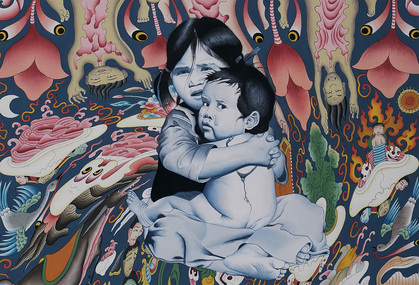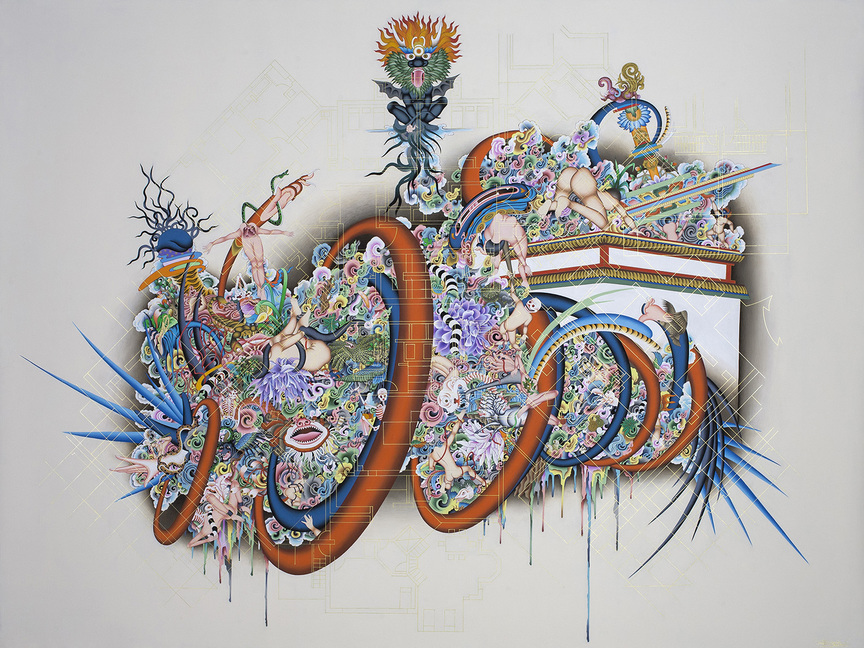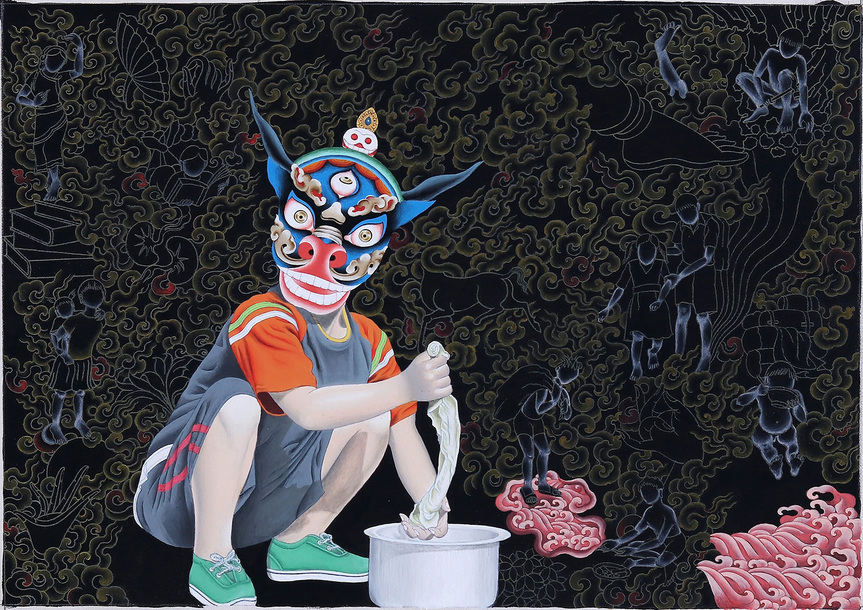-
From Current Issue
-
- Editor’s Letter Fire in the Heart
- Reviews I Gusti Ayu Kadek Murniasih
- Reviews 11th Seoul Mediacity Biennale: “One Escape at a Time”
- Dispatch Networked China
- One on One Monira Al Qadiri on Yukio Mishima
- Essays The rise of independent art spaces in pandemic-era Shanghai
- Features Tuan Andrew Nguyen
- Table of Contents
- Web Exclusives
- Archive
- Subscribe

R
E
V N
E
X
T
Installation view of TSHERIN SHERPA’s “I want…I have…I hope” at Rossi & Rossi, London, 2018. All images courtesy the artist and Rossi & Rossi, London/Hong Kong.
In “I want…I have…I hope,” Tsherin Sherpa adopted the conventions of a range of South Asian miniature painting traditions for the first time, combining these techniques with his longstanding thangka painting practice to reflect the conditions of contemporary Nepal, which, following the devastating Gorkha earthquake of April 2015, has undergone a series of political overhauls. The solo show, presented by Rossi & Rossi in London, is the Kathmandu-born artist’s first since he decided to move back to his home country in 2017 after being based in California for 19 years. The works that were displayed—all but one measure 21 × 30 cm—speak of the forces shaping Nepal: tenets of Buddhism meeting hyper-globalism, geopolitical tensions arising from the country’s position between India and China, and its vulnerability to flooding and earthquakes.
Whereas traditional thangka painting’s focal point is typically the image of Buddha or a high lama for meditation purposes, Sherpa’s vision pivots upon everyday life in the country. His images are treated akin to photojournalistic reportage, with the work titles providing subtle headlines. UPS (2018), an abbreviation of Underprivileged Sherpa, guides viewers’ readings of the miniature work’s central figure—a member of the Sherpa peoples native to the Himalayas, who is seemingly at ease with the load of gas bottles that he bears on his back, presumably for foreign trekkers, and whose profits are low despite the risks of his job.
Sherpa’s practice is anthropological in nature. His concern lies with human experience and personal recollections told directly to him. Children of Heaven I and II (2018), for example, register the emotional conduits of another Nepalese phenomenon. The diptych features three children—one boy smiling voraciously and two siblings grasping each other through fear—and references juvenile ordination. Through the contrasting emotions shown by the subjects, who are depicted against a vortex of thangka iconography, including a flayed man typically associated with protector deities, Sherpa considers the legitimacy and the benefits of monastic living at the beginning of one’s life.
The warped icons in the two painting’s backgrounds are reminiscent of Sherpa’s “UFO (Unidentified Fettering Organisation)” series (2016), which use similarly entangled figures to evoke the chaos of earthquake Gorkha. Yet the collision of thangka motifs with his interpretations of the habitual routines of Nepalese life is not to deride the sacred or prioritize the mundane. Sherpa’s depictions are comments on the spiritual world and its contemporary currency. In “I want…I have…I hope,” ritual belief and its associated narratives and practices were evidenced in Kathmandu Express (2018). A blue horned mask associated with the attainment of spiritual purification and the banishment of evil is used to conceal the face of a religious figure. The mask’s deep-set eyes, encircled with pink rims, look onto a broken landscape of tangled electrical cables, sections of train-tracks and plumes of smoke through which a dragon zigzags. The tracks leading no-where reference the high-speed, pan-Himalayan train connection, brokered by the Chinese and Nepalese government as an act of friendship. Sherpa’s image looks towards the inevitable complexity associated with new mobility, which will be spurred by the railway’s expected completion in 2022.
Madmandu BluesI, II and III (all 2018) similarly convey a sense of confusion. Behind figures wearing masks associated with cham, a ritual dance practice, are densely patterned backgrounds. Within the fine, lightly glistening golden swirls and depictions of Buddhist stories and popular folklore, reality bites. Faceless bodies fall through the patterns, some with limbs pierced by weapons, while others weld mallets and spears. Some of the bodies form mudras and dance atop piles of books. As Sherpa stated to me, his wish is to, “blur the gap between icon and ordinary, sacred and mundane as well as past tradition and contemporary.” His show brought to the fore a country at an intersection between the forces of global politics and the nuances of its local context.
Tsherin Sherpa’s “I want…I have…I hope” is on view at Rossi & Rossi, London, until November 16, 2018.
To read more of ArtAsiaPacific’s articles, visit our Digital Library.















